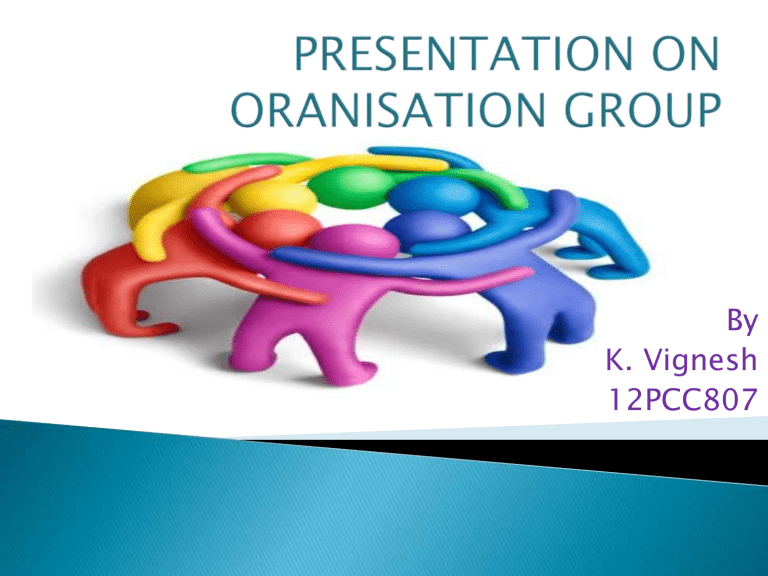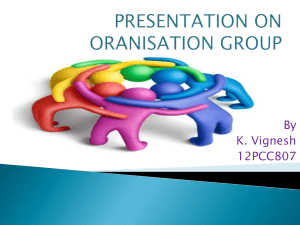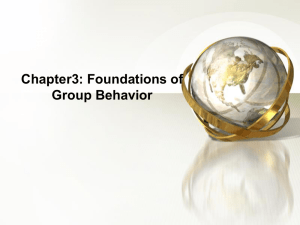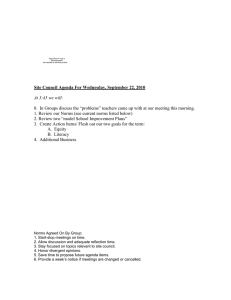Uploaded by
Rogersy L. Mangaba-Maltu
Organizational Groups: Types, Dynamics, and Decision Making
advertisement

By K. Vignesh 12PCC807 The term group refers to two or more individuals who bear an explicit psychological relationship to one another. In general, a number of people together at a given place and given time can be considered as a group. ‘A group is the largest set of two or more individuals who are jointly characterized by a network of relevant communications, a shared sense of collective identify and one or more shared dispositions with associated normative strength’. -By David Horton. INTERACTION AMONG MEMBERS SHARED GOALS PEOPLE SEE THEMSELVES AS MEMBERS TWO OR MORE PEOPLE Formal • Command • Task Informal Primary & Secondary • Interest • Friendship In formal group, the behaviors that one should engage in are stipulated by and directed towards organizational goals. The six members making up an airline flight crew are an example of a formal group. A group is a formal when it is purposely designed to accomplish an organisation objective or task. It is created via a formal authority for some defined purpose. Command group: A command group is determined by the organisational chart. It is composed of the subordinates who report directly to a given manager. An elementary school principal and his/her 12 teacher form a command group, as do the director of postal audits and his five inspectors. Task group: Task groups, also organizationally determined, represent those working together to complete a job task. However, a task group’s boundaries are not limited to its immediate hierarchical superior. It can cross command relationships. Counteraction group: It exists when members interact to resolve some type of conflict, usually through negotiation and compromise. A labor-management negotiating group is one example of a counteracting group. Coaching group: It exists when group members perform their jobs relatively independently in the short run. For example, students enrolled in the same course may participate relatively independently of each other in class discussions but act interdependently with others in under taking a team project. Interacting groups: Interacting group refers to the dynamics of the team and the way individuals in the group interact with one another. Informal groups are the natural and spontaneous grouping of people whenever they work together over a period of time. Whenever people interact and work together over a certain period of time, it’s very natural for them and it comes very spontaneously for them, that they form informal groups. Interest group: Established to meet a mutual objective (a group formed to lobby management for more fringe benefits). Friendship group: Formed because members have something in common. A primary group is typically a small social group whose members share close, personal, enduring relationships. These groups are marked by members' concern for one another, in shared activities and culture. Examples include family, childhood friends, and highly influential social groups. People in a secondary group interact on a less personal level than in a primary group, and their relationships are temporary rather than long lasting. Since secondary groups are established to perform functions, people’s roles are more interchangeable. A secondary group is one you have chosen to be a part of. They are based on interests and activities. Examples of these would be employment, vendor-to-client relationships, etc Security status power Goal achievement Perception approach: People who see themselves as part of group constitute a group. Teams are mature groups with a degree of member interdependence and motivation to achieve common goals. Teams start out as groups, but not all groups become teams. Organization approach: emphasizes group characteristics to define a group: an organized system of individual who are connected with one another. Motivation approach: a group is a collection of individuals whose collective existence satisfies needs. Interaction approach: Two or more individuals interacting with each other in order to accomplish a common goal. This definition specifies three minimum requirements for a group to exist: I. Size—must be two or more individuals. II. Interaction—must be some form of exchange or communication. III. Purpose—must be trying to accomplish a goal. The group dynamics is that division of social psychology that investigates the formation and change in the structure and functions of the psychological grouping of people into self-directing wholes. Group norms are a set of beliefs, feelings and attitudes commonly shared by group members. These are also referred to as rules & standards of behavior that apply to group members. Norms serve three functions in groups: Predictive Control Rational. 1. As first, norms provide a basis for understanding behavior of others 2. Second, norms regulate the behavior of members. 3. Finally, some norms define relationships among roles. A characteristic feature of groups which is particularly important for the behaviour of their members is COHESIVENESS Extent to which the members are attracted to each other. It is the degree to which members are attached to and motivated to remain a part of a group. INTERACTION SOLVING PROBLEMS ATTITUDES & VALUES SHARED GOALS THREAT SIZE COOPERATION Decision making is the process of choosing a course of action among alternatives. It is important to understand decision making process in the organizational behaviour because choice processes play a vital role in communication, motivation, leadership, and other aspects of individual, group and organizational interfaces. DIGNOSE THE PROBLEM DEVELOP ALTERNATIVS EVALUATE ALTERNATIVES AND SELECT THE BEST ONE IMPLEMENTING AND MONITORING Its all clear means then its my time to ask you questions!




